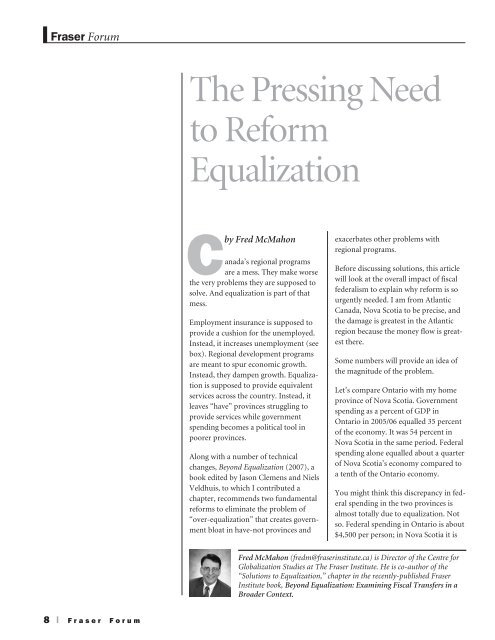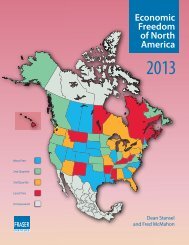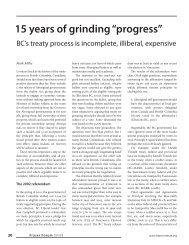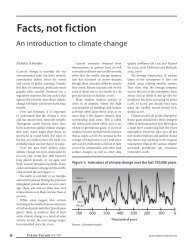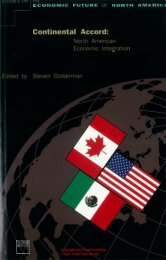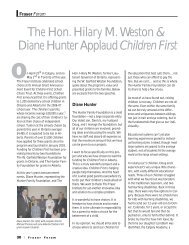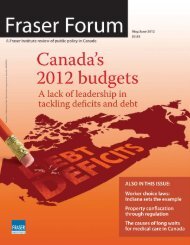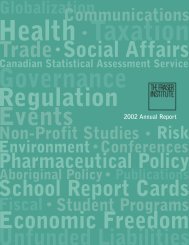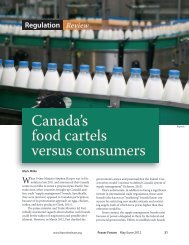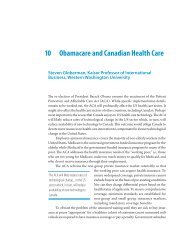Pressing Need to Reform Equalization - Fraser Institute
Pressing Need to Reform Equalization - Fraser Institute
Pressing Need to Reform Equalization - Fraser Institute
You also want an ePaper? Increase the reach of your titles
YUMPU automatically turns print PDFs into web optimized ePapers that Google loves.
<strong>Fraser</strong> Forum<br />
8 | <strong>Fraser</strong> Forum<br />
The <strong>Pressing</strong> <strong>Need</strong><br />
<strong>to</strong> <strong>Reform</strong><br />
<strong>Equalization</strong><br />
by Fred McMahon<br />
Canada’s regional programs<br />
are a mess. They make worse<br />
the very problems they are supposed <strong>to</strong><br />
solve. And equalization is part of that<br />
mess.<br />
Employment insurance is supposed <strong>to</strong><br />
provide a cushion for the unemployed.<br />
Instead, it increases unemployment (see<br />
box). Regional development programs<br />
are meant <strong>to</strong> spur economic growth.<br />
Instead, they dampen growth. <strong>Equalization</strong><br />
is supposed <strong>to</strong> provide equivalent<br />
services across the country. Instead, it<br />
leaves “have” provinces struggling <strong>to</strong><br />
provide services while government<br />
spending becomes a political <strong>to</strong>ol in<br />
poorer provinces.<br />
Along with a number of technical<br />
changes, Beyond <strong>Equalization</strong> (2007), a<br />
book edited by Jason Clemens and Niels<br />
Veldhuis, <strong>to</strong> which I contributed a<br />
chapter, recommends two fundamental<br />
reforms <strong>to</strong> eliminate the problem of<br />
“over-equalization” that creates government<br />
bloat in have-not provinces and<br />
exacerbates other problems with<br />
regional programs.<br />
Before discussing solutions, this article<br />
will look at the overall impact of fiscal<br />
federalism <strong>to</strong> explain why reform is so<br />
urgently needed. I am from Atlantic<br />
Canada, Nova Scotia <strong>to</strong> be precise, and<br />
the damage is greatest in the Atlantic<br />
region because the money flow is greatest<br />
there.<br />
Some numbers will provide an idea of<br />
the magnitude of the problem.<br />
Let’s compare Ontario with my home<br />
province of Nova Scotia. Government<br />
spending as a percent of GDP in<br />
Ontario in 2005/06 equalled 35 percent<br />
of the economy. It was 54 percent in<br />
Nova Scotia in the same period. Federal<br />
spending alone equalled about a quarter<br />
of Nova Scotia’s economy compared <strong>to</strong><br />
a tenth of the Ontario economy.<br />
You might think this discrepancy in federal<br />
spending in the two provinces is<br />
almost <strong>to</strong>tally due <strong>to</strong> equalization. Not<br />
so. Federal spending in Ontario is about<br />
$4,500 per person; in Nova Scotia it is<br />
Fred McMahon (fredm@fraserinstitute.ca) is Direc<strong>to</strong>r of the Centre for<br />
Globalization Studies at The <strong>Fraser</strong> <strong>Institute</strong>. He is co-author of the<br />
“Solutions <strong>to</strong> <strong>Equalization</strong>,” chapter in the recently-published <strong>Fraser</strong><br />
<strong>Institute</strong> book, Beyond <strong>Equalization</strong>: Examining Fiscal Transfers in a<br />
Broader Context.
almost $10,000 per person. And when<br />
you subtract equalization, it’s still about<br />
$8,000 per person. In other words,<br />
Ottawa spends nearly twice as much per<br />
person in Nova Scotia as Ontario not<br />
even counting equalization, and more<br />
than twice as much when equalization is<br />
counted.<br />
The damage done<br />
The great burst of spending in Atlantic<br />
Canada <strong>to</strong>ok off under Pierre Trudeau<br />
in the early 1970s, a time of minority<br />
government when buying seats in the<br />
region could make the difference between<br />
vic<strong>to</strong>ry and loss, minority or majority government.<br />
Federal spending has maintained<br />
its political edge ever since.<br />
Ottawa spends<br />
nearly twice as<br />
much per person<br />
in Nova Scotia as<br />
Ontario not<br />
counting<br />
equalization...<br />
Let’s take a look at how these transfers<br />
undermine economic growth, leave<br />
“have” provinces struggling <strong>to</strong> provide<br />
services, and result in government bloat<br />
in the have-not provinces.<br />
A study sponsored by the government<br />
of Nova Scotia and the Atlantic Canada<br />
Opportunities Agency, which was supposed<br />
<strong>to</strong> show that Nova Scotia businesses<br />
were competitive, instead found<br />
that the corrosive effects of government<br />
Regional Programs<br />
spending were undermining competitiveness.<br />
[A] significant proportion of the<br />
Nova Scotia firms visited were partially<br />
dependent either directly<br />
upon provincial or other forms of<br />
public purchasing or indirectly<br />
through subcontracting <strong>to</strong> larger<br />
firms which are in turn reliant<br />
upon government spending for<br />
their survival and profitability....<br />
Public policy appears inadvertently<br />
<strong>to</strong> have reinforced market failure <strong>to</strong><br />
some extent by cushioning profits<br />
via grants, subsidies and preferential<br />
purchasing thereby reducing the incentive<br />
<strong>to</strong> change.... The heavy reliance<br />
upon Federal transfers has<br />
indirectly promoted a dependency<br />
culture in the province...a culture,<br />
as one owner manager said of “a<br />
whole region being on the dole.”<br />
(O’Farrell, 1990, pp. 24-25. Emphasis<br />
in the original)<br />
Federal transfers <strong>to</strong> poorer provinces,<br />
including equalization, provide the<br />
money for these provinces <strong>to</strong> undermine<br />
the competitiveness of provincial<br />
businesses through subsidies and generous<br />
government contracts that leave<br />
businesses dependent on government.<br />
(See McMahon, 2000, chapter 5 for<br />
more details.)<br />
Meanwhile, Ontario struggles <strong>to</strong> provide<br />
health care (with 2.7 hospital beds<br />
per thousand population, below the<br />
national average of 3.6), while Nova<br />
Scotia boasts four beds per thousand<br />
and New Brunswick leads the pack at<br />
5.3. Even Alberta lags all “have-not”<br />
provinces except PEI (MacKinnon,<br />
2005, citing 2003 numbers).<br />
Solutions<br />
While there are strong arguments <strong>to</strong><br />
eliminate equalization, Beyond <strong>Equalization</strong><br />
limits itself <strong>to</strong> recommending<br />
Unemployment in the<br />
Maritimes<br />
Prior <strong>to</strong> the introduction of highly generous,<br />
regionally extended Unemployment<br />
Insurance in the early 1970s,<br />
every Maritime province had spent at<br />
least one year below the national unemployment<br />
rate and regional and national<br />
unemployment were converging.<br />
Afterwards, unemployment in the region<br />
soared <strong>to</strong> about 50 percent higher than<br />
the national average. UI became such a<br />
disincentive <strong>to</strong> work that in some<br />
months more than twice as many people<br />
collected UI as were officially unemployed.<br />
They didn’t count as officially<br />
unemployed because they s<strong>to</strong>pped looking<br />
for work while collecting UI.<br />
With a real unemployment rate of<br />
around 20 percent, both Statistics Canada<br />
and the Atlantic Provinces Economic<br />
Council reported labour<br />
shortages throughout the region after<br />
the creation of regionally extended UI.<br />
Business growth was frustrated because<br />
businesses, small business in particular,<br />
couldn’t compete against the UI system.<br />
(See McMahon, 2000, chapter 5 for a<br />
full discussion of these issues.)<br />
sensible reforms <strong>to</strong> the program in light<br />
of overall fiscal federalism. Unfortunately,<br />
other studies of equalization<br />
have failed <strong>to</strong> recommend fundamental<br />
reforms and typically recycle previous<br />
versions of the system.<br />
Respect the constitution<br />
The first task is a reform that goes well<br />
beyond the equalization debate but<br />
would solve many of the perversities in<br />
the equalization system. Ottawa should<br />
remove itself from areas of provincial<br />
jurisdiction, end its fiscal transfers in<br />
March 2007 | 9
these areas, and open an equivalent<br />
amount of tax room for the provinces.<br />
There are many reasons for this reform<br />
outside of the equalization context:<br />
respect for Canada’s constitution,<br />
replacing federal-provincial finger-pointing<br />
with accountability and<br />
transparency by making one level of<br />
government responsible for programs<br />
like health care, allowing provinces <strong>to</strong><br />
tailor programs <strong>to</strong> the unique needs of<br />
their people. (See Clemens, Veldhuis,<br />
and Palacios, 2006; and Harris and<br />
Manning, 2005a and 2005b for a fuller<br />
discussion of the need for these<br />
reforms.)<br />
At a stroke this would end a large part<br />
of the over-equalization problem. As the<br />
Expert Panel on <strong>Equalization</strong> and Terri<strong>to</strong>rial<br />
Financing Formula noted:<br />
As if the <strong>Equalization</strong> program<br />
isn’t complicated enough on its<br />
own, other federal transfer programs,<br />
particularly the Canada<br />
Health Transfer and the Canada<br />
Social Transfer, also include an<br />
equalizing component. …. The result<br />
is that wealthier provinces like<br />
Ontario and Alberta receive lower<br />
cash payments than other provinces.<br />
(2006, p. 47)<br />
Base equalization on costs<br />
The second key reform is <strong>to</strong> base equalization<br />
on the cost of providing services.<br />
Here it is important <strong>to</strong> remember the<br />
actual intent of the equalization program.<br />
The constitution does not require<br />
that provinces receive equal revenues<br />
but rather that they be able <strong>to</strong> provide<br />
reasonably comparable services at reasonably<br />
comparable levels of taxation.<br />
And here, reality bites. It simply costs<br />
more <strong>to</strong> provide services, or build hospitals,<br />
in Toron<strong>to</strong> or Vancouver than in<br />
New Glasgow, Nova Scotia, or<br />
10 | <strong>Fraser</strong> Forum<br />
Regional Programs<br />
Saska<strong>to</strong>on, Saskatchewan. And this<br />
needs <strong>to</strong> be recognized in equalization<br />
payments.<br />
Unless this is recognized in the equalization<br />
formula, then the intent of the constitution<br />
will be violated in that poorer<br />
provinces, with a lower cost of living,<br />
will always be able <strong>to</strong> provide better services<br />
than richer provinces at the same<br />
level of expenditure.<br />
<strong>Reform</strong>ing equalization by itself will not<br />
clean up the mess of fiscal federalism<br />
but, by keeping in view the larger picture,<br />
the recommended reforms will<br />
reduce some of the perversities of fiscal<br />
federalism. The two key reforms discussed<br />
here are only part of a broader<br />
package of reforms, many of them technical,<br />
discussed in Beyond <strong>Equalization</strong>.<br />
References<br />
Clemens, Jason, Niels Veldhuis, and<br />
Milagros Palacios (2006). “Fiscal Balance,<br />
the GST, and Decentralization: An<br />
Opportunity for <strong>Reform</strong>.” In Veldhuis<br />
and Clemens, eds. Beyond <strong>Equalization</strong>:<br />
Examining Fiscal Transfers in a Broader<br />
Context. Vancouver: The <strong>Fraser</strong> <strong>Institute</strong>.<br />
Clemens, Jason and Niels Veldhuis, eds.<br />
(2007). Beyond <strong>Equalization</strong>: Examining<br />
Fiscal Transfers in a Broader Context.<br />
Vancouver: The <strong>Fraser</strong> <strong>Institute</strong>.<br />
Council of the Federation. (2006). Reconciling<br />
the Irreconcilable. Ottawa. Digital<br />
document available at http://www.councilofthefederation.ca/pdfs/Report_Fiscalim_<br />
Mar3106.pdf.<br />
Expert Panel on <strong>Equalization</strong> and Terri<strong>to</strong>rial<br />
Financing Formula [EPETF] (2006).<br />
Achieving a National Purpose: Putting<br />
<strong>Equalization</strong> Back on Track (May 2006).<br />
Ottawa: Government of Canada, Department<br />
of Finance. Digital document available<br />
at www.eqtff-pfft.ca/.Harris, Mike<br />
and Pres<strong>to</strong>n Manning (2005a). A Canada<br />
Strong and Free. Vancouver: The <strong>Fraser</strong><br />
<strong>Institute</strong>.<br />
Harris, Mike and Pres<strong>to</strong>n Manning (2005b).<br />
Caring for Canadians in a Canada Strong<br />
and Free. Vancouver: The <strong>Fraser</strong> <strong>Institute</strong>.<br />
MacKinnon, David (2005). Fairness in Confederation—Fiscal<br />
Imbalance: A Roadmap<br />
<strong>to</strong> Recovery—Phase 2 Report. Toron<strong>to</strong>:<br />
Ontario Chamber of Commerce.<br />
McMahon, Fred (2000). Retreat from<br />
Growth: Atlantic Canada and the Negative<br />
Sum Economy. Halifax: Atlantic <strong>Institute</strong><br />
for Market Studies.<br />
O’Farrell, P.N. (1990). Small Manufacturing<br />
Competitiveness and Performance: An<br />
Analysis of Matched Pairs in Nova Scotia<br />
and New England. In association with<br />
Gardner Pinfold Consultants. Halifax:<br />
The Nova Scotia Department of Industry,<br />
Trade and Technology and the Atlantic<br />
Canada Opportunities Agency.


